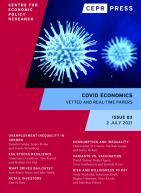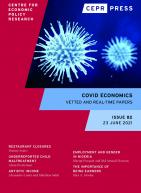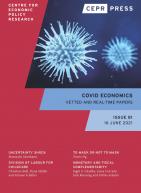
Covid-19 is the single largest threat to global public health since the Spanish Influenza pandemic of 1918-20. Was the world better prepared in 2020 than it was in 1918? After a century of public health and basic science research, pandemic response and mortality outcomes should be better than in 1918-20. We ask whether historical mortality from pandemics has any predictive content for mortality in the ongoing Covid-19 pandemic. We find a strong persistence in public health performance in the early days of the Covid-19 pandemic. Places that performed poorly in terms of mortality in 1918 were more likely to have higher mortality today. This is true across countries and across a sample of US cities. Experience with SARS is associated with lower mortality today. Distrust of expert advice, lack of cooperation at many levels, over-confidence, and health care supply shortages have likely promoted higher mortality today as in the past.
Citation
Meissner, C and Z Lin (2020), ‘A Note on Long-Run Persistence of Public Health Outcomes in Pandemics‘, COVID Economics 15, CEPR Press, Paris & London. https://cepr.org/publications/covid-economics-issue-15#392514_392891_390429
This paper considers a modification of the standard Susceptible-Infected-Recovered (SIR) model of epidemic that allows for different degrees of compulsory as well as voluntary social distancing. It is shown that the fraction of population that self-isolates varies with the perceived probability of contracting the disease. Implications of social distancing both on the epidemic and recession curves are investigated and their trade off is simulated under a number of different social distancing and economic participation scenarios. We show that mandating social distancing is very effective at flattening the epidemic curve but is costly in terms of employment loss. However, if targeted towards individuals most likely to spread the infection, the employment loss can be somewhat reduced. We also show that voluntary self-isolation driven by individual's perceived risk of becoming infected kicks in only towards the peak of the epidemic and has little or no impact on flattening the epidemic curve. Using available statistics and correcting for measurement errors, we estimate the rate of exposure to COVID-19 for 21 Chinese provinces and a selected number of countries. The exposure rates are generally small but vary considerably between Hubei and other Chinese provinces as well as across countries. Strikingly, the exposure rate in Hubei province is around 40 times larger than the rates for other Chinese provinces, with the exposure rates for some European countries being 3-5 times larger than Hubei (the epicenter of the epidemic). The paper also provides country-specific estimates of the recovery rate, showing it to be about 21 days (a week longer than the 14 days typically assumed), and relatively homogeneous across Chinese provinces and for a selected number of countries.
Citation
Pesaran, M, A Rebucci and A Chudik (2020), ‘Voluntary and Mandatory Social Distancing: Evidence on COVID-19 Exposure Rates from Chinese Provinces and Selected Countries‘, COVID Economics 15, CEPR Press, Paris & London. https://cepr.org/publications/covid-economics-issue-15#392514_392891_391027
Using real-time register data we document the magnitude, dynamics and socio-economic characteristics of the crisis-induced temporary and permanent layoffs in Norway. We find evidence that the effects of social distancing measures quickly spread to industries that were not directly affected by policy. Close to 90% of layoffs are temporary, although this classification may change as the crisis progresses. Still, there is suggestive evidence of immediate stress on a subset of firms that manifests itself in permanent rather than temporary layoffs. We find that the shock had a strong socio-economic gradient, hit a financially vulnerable population, and parents with younger children, and was driven by layoffs in smaller, less productive, and financially weaker firms. Consequently though, the rise in unemployment likely overstates the loss of output associated with the layoffs by about a third.
Citation
Raaum, O, K Røed, S Markussen, W Kopczuk, G Eielsen, B Bratsberg and A Alstadsæter (2020), ‘The first weeks of the coronavirus crisis: Who got hit, when and why? Evidence from Norway‘, COVID Economics 15, CEPR Press, Paris & London. https://cepr.org/publications/covid-economics-issue-15#392514_392891_390430
We develop and calibrate a search-theoretic model of the labor market in order to forecast the evolution of the aggregate US labor market during and after the coronavirus pandemic. The model is designed to capture the heterogeneity of the transitions of individual workers across states of unemployment, employment and across different employers. The model is also designed to capture the trade-offs in the choice between temporary and permanent layoffs. Under reasonable parametrizations of the model, the lockdown instituted to prevent the spread of the novel coronavirus is shown to have long-lasting negative effects on unemployment. This is so because the lockdown disproportionately disrupts the employment of workers who need years to find stable jobs.
Citation
Menzio, G, D Wiczer and V Gregory (2020), ‘Pandemic Recession: L or V Shaped?‘, COVID Economics 15, CEPR Press, Paris & London. https://cepr.org/publications/covid-economics-issue-15#392514_392891_390431
This paper presents an economic model of an epidemic in which susceptible individuals may engage in costly social distancing in order to avoid becoming infected. Infected individuals eventually recover and acquire immunity, thereby ceasing to be a source of infection to others. Under non-cooperative and forward-looking decision making, equilibrium social distancing arises endogenously around the peak of the epidemic, when disease prevalence reaches a critical threshold determined by preferences. Spontaneous, uncoordinated social distancing thus acts to flatten the curve of the epidemic by reducing peak prevalence. In equilibrium, social distancing stops once herd immunity sets in, but acts to extend the duration of the epidemic beyond the benchmark of a non-behavioral epidemiological model. Comparative statics with respect to the model parameters indicate that the curve becomes flatter(i) the more infectious the disease is and (ii) the more severe the health consequences of the disease are for the individuals.
Citation
Toxvaerd, F (2020), ‘Equilibrium Social Distancing‘, COVID Economics 15, CEPR Press, Paris & London. https://cepr.org/publications/covid-economics-issue-15#392514_392891_390432
We provide an initial assessment of the US Paycheck Protection Program by studying the 273 public firms that received a total of $929 million in loans between April 7 - 27, 2020. Despite receiving significant media coverage, these firms comprise 0.3% of the funds disbursed. Using guidelines specified by the US Small Business Administration, we document that about half of public firms were eligible to apply, of which 13% were eventual borrowers. Within the set of eligible firms, public firm borrowers tended to be smaller, have more employees, have fewer investment opportunities, have preexisting debt balances, and be located in a county with COVID-19 cases. Implementing additional eligibility requirements may help target funds towards the most constrained firm.
Citation
Rosen, S and A Cororaton (2020), ‘Public Firm Borrowers of the US Paycheck Protection Program.‘, COVID Economics 15, CEPR Press, Paris & London. https://cepr.org/publications/covid-economics-issue-15#392514_392891_390433
This paper analyzes the epidemiological and economic effects of quarantines. We use a basic epidemiological model, a SEIR-model, that is calibrated to roughly resemble the COVID-19 pandemic, and we assume that individuals that become infected or are isolated on average lose a share of their productivity. An early quarantine postpones but does not alter the course of the pandemic at a cost that increases in the duration and the extent of the quarantine. For quarantines at later stages of the pandemic there is a trade-off between lowering the peak level of infectious people on the one hand and minimizing fatalities and economic losses on the other hand. A longer quarantine dampens the peak level of infectious people and also reduces the total number of infected persons but increases economic losses. Both the peak level of infectious individuals and the total share of the population that will have been infected are U-shaped in relation to the share of the population in quarantine, while economic costs increase in this share. In particular, a quarantine covering a moderate share of the population leads to a lower peak, fewer deaths and lower economic costs, but it implies that the peak of the pandemic occurs earlier.
Citation
Herzing, M and R Forslid (2020), ‘Assessing the Consequences of Quarantines During a Pandemic‘, COVID Economics 15, CEPR Press, Paris & London. https://cepr.org/publications/covid-economics-issue-15#392514_392891_391028
Less impacted than the rest of the world, the African continent is also facing the spread of Covid 19 and the numbers of confirmed cases are rising. This paper estimates the short-term impact of COVID-19 on poverty in Africa using the World Bank’s PovcalNet dataset. Three scenario were used including low, medium and high consumption contractions of 10%, 20% and 30%. The impact is estimated based on the US$ 1.90 per day poverty line. First, the impact of COVID-19 is estimated for the whole Africa. Secondly, to account for the regional heterogeneity, the impact is estimated separately for the five regions in Africa. The results indicate that the number of poor people in Africa would increase by between 59 – 200 million due to contractions in consumption as a result of COVID-19 pandemic. In all three scenario, West Africa and East Africa are the most affected by contractions in consumption due to the COVID-19 pandemic, while North Africa is the least affected among the five regions in Africa. The findings suggest that COVID-19 pandemic is a serious threat for achieving the Sustainable Development Goals (SDGs). Therefore, governments and international organizations should increase efforts in supporting the economic activities in all countries.
Citation
Nonvide, G (2020), ‘Short-term impact of COVID-19 on poverty in Africa‘, COVID Economics 15, CEPR Press, Paris & London. https://cepr.org/publications/covid-economics-issue-15#392514_392891_390434


Covid Economics - Issue 82
- Restaurant Closures during the Pandemic: A Descriptive Analysis
- Underreporting Child Maltreatment during the Pandemic: Evidence from Colorado
- Covid-19 impact on Artistic Income
- COVID-19, Employment, and Gender: Evidence from Nigeria
- The Importance of Being Earners: Modelling the Implications of Changes to Welfare Contributions on Macroeconomic Recovery
